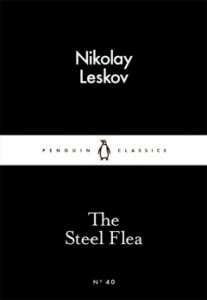The 19th century was an extraordinarily rich period for Russian literature. Among the numerous gifted and productive authors of that period is at least one that – according to my impression – is not valued and read outside Russia as much as he would deserve it: Nikolay Leskov.
His probably best work The Steel Flea (full title: The Tale of the Cross-Eyed Left-Handed Gunsmith from Tula and the Steel Flea) contains on about 50 pages everything that makes this author so interesting in a nutshell, such as: a folk-like story about an unsung Russian everyday-life hero of the past; a narrative spiced with mild irony; a playful voice that uses many neologisms that are so up to the point that many of them achieved proverbial status and found their way into everyday communication of many Russians; a not condescending sympathy of the author/narrator with the “ordinary people”.
What is it about: Czar Alexander I (we are in the 1820s, more than half a century before Leskov wrote the story) is visiting England, then the technically most developed country; he is accompanied by Platov, a Cossack ataman, who represents the ordinary Russian that is proud and less easy to impress than the Czar by the display of technical superiority with which the English hosts shower their Royal guest. While the Czar views everything he sees as a sign of the hopeless inferiority and backwardness of his country, Platov makes it clear to the Czar that he thinks otherwise (ironically his opinion is confirmed in one instance much to the embarrassment of the hosts.)
As a gift, the Czar receives a tiny steel flea that can even perform a dance when properly wound up. How this complicated and perfectly crafted mechanism that can be seen properly under a strong microscope only is constructed is not revealed and leaves the Czar wondering how such a miracle of engineering was possible.
After the coronation of Alexander’s brother Nikolay a few years later, the steel flea becomes a political issue. Platov, in the meantime retired, is re-activated to service in order to investigate if somewhere in Russia craftsmen can do something that even “tops” the English feat of the dancing steel insect. Platov finds in Tula a left-handed and cross-eyed craftsman who, together with several of his colleagues indeed “improves” the English invention. (You have to read by yourself how.)
In the end, the Russians have a field day to see the impressed English who cannot believe their eyes when a Russian delegation with Lefty is visiting the island. So impressed are they this time that they try to lure the nameless Lefty to stay in England; but to no avail: the man from Tula is homesick and returns to Russia, where he dies soon after his arrival as a consequence of a drinking contest with a sailor. The last important message he has and that could have change the fate of Russia is not delivered.
In the end, Leskov tells his readers:
Lefty’s real name, like the names of many of the greatest geniuses, has been lost to posterity forever; but he is interesting as the embodiment of a myth in the popular imagination, and his adventures can serve to remind us of an epoch whose general spirit has been portrayed here clearly and accurately.
It goes without saying that Tula no longer has such master craftsmen as the legendary Lefty: machines have evened up the inequalities in gifts and talents, and genius no longer strains itself in a struggle against diligence and exactness. Even though they encourage the raising of salaries, machines do not encourage artistic, daring, which sometimes went so far beyond ordinary bounds as to inspire the folk imagination to create unbelievable legends like this one.
One of the things I like particularly are Leskov’s neologisms that are translated quite ingeniously in the edition I had at hand. For example: the steel flea and its dance can be seen properly only when viewed under a strong microscope, or nitroscope – as the narrator says (it seems Leskov was the Godfather of nanotechnology); and when the steel flea is dancing, he is doing it in various fairiations.
Another thing I found amusing was the fact that the steel flea, a childish toy after all, becomes a state affair and the main object of national pride of two European leaders and their nations they represent; on a more serious note: how much better seem these old times to be where a Russian leader paid attention to the shoe strings of a tiny steel flea – especially considering most of the Russian leaders that came later… – !
Leskov had a difficult time as a writer in his days. The progressives viewed him as a conservative, the conservatives suspected him to be a leftist; the Slavophiles considered him as a propagandist of Western modernism, and the Westerners saw in him a romantic that was spreading nostalghia for Russia’s backwardness. A writer whose work is still so fresh and who was caught between so many stools is definitely worth it to be read again.
My edition was the one from Penguin’s “Little Black Classics”. This series contains many (re-)discoveries; the small format and limited number of pages make it (together with the very attractive price) the perfect companion for the daily commuting routine or on other occasions. When you carry (like me) always at least one book with you to use every opportunity for reading, this is an excellent series for you.
Nikolay Leskov: The Steel Flea, translated by William Edgerton, London 2015
© Thomas Hübner and mytwostotinki.com, 2014-5. Unauthorized use and/or duplication of this material without expressed and written permission from this blog’s author and/or owner is strictly prohibited. Excerpts and links may be used, provided that full and clear credit is given to Thomas Hübner and mytwostotinki.com with appropriate and specific direction to the original content.




 Facebook
Facebook RSS
RSS Twitter
Twitter